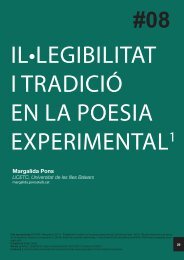03 - 452ºF
03 - 452ºF
03 - 452ºF
You also want an ePaper? Increase the reach of your titles
YUMPU automatically turns print PDFs into web optimized ePapers that Google loves.
interpret sentimental or romance fiction as definitive statements on<br />
women’s prose craftsmanship» (Harzewski, 2006: 29).<br />
Female writers have always been fully aware that their work was<br />
viewed as sub-standard and unimportant, but, instead of deterring<br />
them from writing, it seems to have made them all the more determined<br />
to succeed and make their voices heard. Jane Austen herself believed<br />
that women’s novels, «for all their incidental silliness, are important<br />
enough in women’s negotiation with the world to be worth defending<br />
against detractors» (Blair, 2000: 21-22). Austen uses novels such as<br />
Northanger Abbey to plead for women writers not to turn against one<br />
another, but instead to unite against their critics. As she puts it, «if<br />
the heroine of one novel be not patronised by the heroine of another,<br />
from whom can she expect protection and regard? [...] Let us not<br />
desert one another; we are an injured body» (Austen, 1993: 19).<br />
Chick lit is the latest genre of women’s writing to be ridiculed and<br />
criticized. Even though we are now in the twenty-first century, it seems<br />
not much has changed in terms of the reception of women’s novels,<br />
as many of the same criticisms are used today regarding chick lit as<br />
they were in the nineteenth century in relation to the female writers<br />
of that time. For many, the phrase «chick lit» is seen as a derogatory<br />
term used to dismiss «any possible literary worth in a text which deals<br />
with the intimate life of a young urban professional single woman»<br />
(Whelehan, 2005: 213). The phrase implies «that this is reading for<br />
women only, or not just women but ‘chicks’; women not even bright<br />
enough to be afforded the title of women» (Levenson, 2009: 90).<br />
In keeping with the centuries-old tradition of criticizing the work of<br />
female writers, it has been noted that critics «and even other female<br />
writers (ones who fancy themselves serious, literary novelists) tend<br />
to treat chick lit as some sub-par version of Real Writing» (Mlynowski,<br />
2006: 14). Merrick provides this somewhat harsh description of her<br />
perceived differences between «chick lit» and «real literature»:<br />
Chick lit’s formula numbs our senses. Literature, by contrast, grants us<br />
access to countless new cultures, places, and inner lives. Where chick lit<br />
reduces the complexity of the human experience, literature increases our<br />
awareness of other perspectives and paths. Literature employs carefully<br />
crafted language to expand our reality, instead of beating us over the<br />
head with clichés that promote a narrow worldview. Chick lit shuts down<br />
our consciousness. Literature expands our imaginations. (Merrick, 2006:<br />
9)<br />
One reason for chick lit’s unfair criticism may be simply because chick<br />
lit represents the connection between women’s writing and popular<br />
culture, both of which have traditionally been ridiculed, thus resulting<br />
in chick lit inevitably receiving the same treatment:<br />
Trivial or Commendable? : Women’s Writing, Popular Culture, and Chick Lit - Mary Ryan<br />
<strong>452ºF</strong>. #<strong>03</strong> (2010) 70-84.<br />
80










